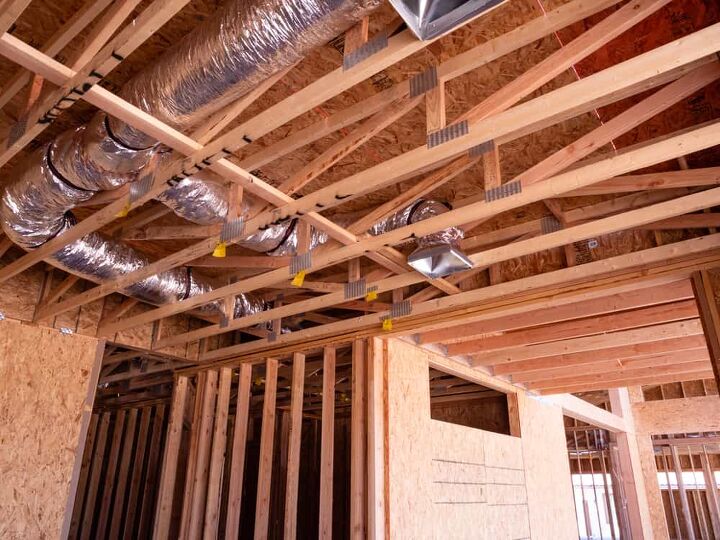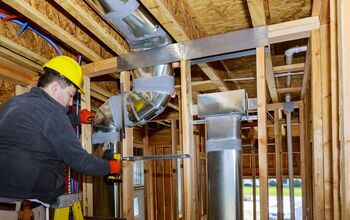HVAC Duct Sizing Rule of Thumb (Ultimate Guide)

While going through the process of building your home, you’ll eventually have to consider how the ducts will be designed. You cannot overlook the ductwork because doing so will affect the type of comfort you’re able to experience at home. However, when it comes to determining an HVAC duct sizing rule of thumb, you need to avoid generalizations.
If you are considering upgrading your heating or air conditioning system, get a quote from local contractors in your area here.
A good HVAC duct sizing rule of thumb is to measure rooms in your home, the necessary airflow rates, and friction loss rate. Using these numbers you can calculate the appropriate HVAC duct size. For example, a one-to AC system typically uses 10-inch ducts, while a 4-ton AC system requires 18-inch ducts.
There are several variables to consider when it comes to ductwork design, and among the most important ones is the size. How big do the ducts need to be to ensure they fit your home properly? Figuring out how big the ducts need to be inside your home can be a very complex undertaking — this guide will help you by sorting through the important details.
Why Is Duct Size Important?
Let’s tackle one of the more important questions related to HVAC duct sizing. To be more specific, let’s try to answer why getting the duct size right is so important. It helps to first understand what the ducts do in your home. They basically work as delivery and return channels.
When you turn on your air conditioner, the cold air quickly moves through the ducts. It will continue to move until it finds a space it can flow into and fill. While doing so, the cold air will also push out the stale air through the other ducts nearby.
The same thing happens when you turn on your furnace. The hot air moves in the same way until the desired temperature is achieved. Some homeowners might assume that the ducts will be able to do their job as long as they’re sealed and connected. It’s true that the ducts will still be able to deliver some of the desired air, but they will struggle.
Larger vs. Smaller Ducts
Smaller ducts will have problems because they will cause the fresh air to pool near the HVAC unit. Not enough of the fresh air will make it to the rooms you want to heat or cool. The HVAC unit will have to work overtime just to provide a moderate amount of heating or cooling.
Now, if the ducts are too big, the fresh air may not be able to move fast enough through them. Since there’s so much space in the ducts, the fresh air may fill them instead of the rooms in your home. You will not be able to get comfortable because of that.
Install incorrectly-sized ducts and you could wind up with more expensive utility bills and a less comfortable home. Even adding other elements such as vents may be tougher with wrong-sized ducts. Simply put, your home will suffer from having the wrong vents installed.
You want a home that can remain comfortable throughout the year. Installing ducts that fit it perfectly will help with that goal.
The Main Factors to Consider When Calculating HVAC Duct Size
Calculating HVAC duct size requires gathering precise figures and making complex calculations. For this article, let’s focus on the numbers you need to collect.
The Square Footage Measurements Of The Rooms In Your Home
First off, we need to understand how much space we have to fill using the ducts. To do that, you must take measurements of your home and eventually calculate the square footage.
We’re also not just talking about the square footage of your home as a whole. You have to take the time to measure the rooms individually. That will help you get a more precise figure. Some rooms will be easy to measure especially if they’re rectangular in shape. Others will be harder to measure given their irregular form.
You can certainly take down the measurements yourself, but leaving that job to the professionals is not a bad idea. They have more experience dealing with oddly shaped rooms and they’ll be able to come up with more precise measurements.
The Airflow Rate
The airflow rate is not the same thing as velocity. Velocity refers to how much ground air covers relative to time. Meanwhile, the airflow rate highlights air output as it relates to time.
You use velocity when you’re trying to figure how much ground an object can cover over a certain period of time. Airflow rate tells you how quickly the air can fill up a certain space.
For the purposes of measuring duct size, we’ll need to determine the airflow rate. Notably, the unit we’ll be using here is cubic feet per minute or CFM. In order to calculate for the CFM, you must first gather some other figures. You must know the square footage of a particular room, the size of your HVAC unit in tons, and its output.
Start calculating by multiplying the size of the HVAC unit with its output. Next, divide that number by the square footage of the room you’re fitting with the new ducts. That final answer is the airflow rate you will have to consider when coming up with the right duct size.
The Friction Loss Rate
The next factor to figure out is the friction loss rate of your ducts. Knowing the correct friction loss rate will help with promoting smoother airflow.
The features of the ducts will have to be taken into consideration when measuring the friction loss rate. It’s not just the size of the duct that you have to consider. You should also look at features like the coils, filters, and grills.
Unless you’re very familiar with ducts and their elements, solving for the friction loss rate will be tricky. Go ahead and let the professionals handle those calculations.
Other Factors That Could Affect HVAC Duct Sizing Calculations
After pinning down the square footage of your home, the airflow rate, and the friction loss rate, you can start calculating. You should be able to come up with a good number. However, there are other variables that could mess up your calculations and affect how compatible the ducts are with your home.
Let’s talk about those other variables in this section.
The Unique Qualities Of The Rooms
Hypothetically, let’s say that your bedroom and kitchen are the same size and shape. Does that mean that they need similarly sized ducts? That may not be the case.
When coming up with the right duct size for a particular room, you have to consider its qualities. Consider how hot it tends to be in there and if windows are present. You also have to consider how often a room is used when coming up with duct size.
Try to fit the ducts to the individual rooms as best you can. That’s the best way to ensure that each and every part of the home receives the cooling or heating it needs.
The Layout Of Your Home
You want to avoid overloading specific parts of your home with ducts. If that happens, all the hot or cold air could pool in those spots instead of spreading throughout your home.
While working with your contractor, remember to mention that you want the ducts to be evenly distributed. Spacing out those ducts properly will lead to the creation of a more comfortable home.
The Connections In The Ductwork
If you’re replacing all the ductwork in your home, then you won’t need to worry about the connections. Replacing all the ductwork at once can be expensive though. You may want to keep some of the old ducts to save money.
The problem with keeping some of those old ducts is that their connections may have deteriorated over the years. You will have to do something about those connections as the new ducts are set in place.
Should You Do Your Own HVAC Duct Sizing?
You can do your own numbers if you want to get a ballpark idea of what you need, but it’s best to not rely solely on your numbers. Yes, after taking all the measurements and considering all the variables, you now have everything needed to proceed with HVAC duct sizing. You can then browse online and you’ll even find calculator tools that will help you come up with the right numbers.
However, while you’re certainly free to use those calculator tools yourself, know that they aren’t foolproof. There’s a chance you’re missing something and failing to factor it into the calculations. You could still end up in the right ballpark, but the precise numbers may elude you.
Since you’re already enlisting the help of professionals, relying on them to make the calculations too is not a bad idea. The numbers they’ll produce will be more accurate and you’ll be able to secure ducts that fit your home better.
The many years of experience they have working on homes will also help them when the time comes to make measurements. Don’t shy away from asking for their help especially if doing so means you will have a more comfortable home.
Related Questions
What materials are used to make ducts?
Manufacturers turn to different materials when fabricating ducts to use inside buildings and homes. The different materials present varied strong points too. For example, metal ducts are lauded for their durability. Metal ducts are often galvanized in order to keep them from rusting over. Galvanizing the metal ducts also improves their longevity.Fiberglass ducts excel in terms of energy efficiency and noise reduction. Plastic ducts are probably the easiest to install. It’s also possible to use a combination of materials to create your duct system.Tell your contractor about what you want your ducts to be and let them recommend a material choice to you. Getting the material choice right will turn the ducts into better additions to your home.
How often should you have a professional clean your ducts?
The ducts put in a lot of work. That means they have to be cleaned regularly, right? As it turns out, your ducts don’t need a lot of maintenance.If you’re worried about dirt particles and debris getting into your home via the ducts, you don’t need to be. Those particles will often stay lodged inside the ducts themselves. While stuck there, they won’t pose much of a threat to your health. Cleaning the ducts is recommended if you suspect they’ve been invaded by pests or if mold is growing inside them. You should also get them cleaned if they’ve become clogged with dirt and debris. Unless those things are happening though, cleaning your ducts is not a necessity.
UpgradedHome participates in affiliate programs. When you purchase through our links, we may earn a commission.

We are a team of passionate homeowners, home improvement pros, and DIY enthusiasts who enjoy sharing home improvement, housekeeping, decorating, and more with other homeowners! Whether you're looking for a step-by-step guide on fixing an appliance or the cost of installing a fence, we've here to help.
More by Upgraded Home Team



























